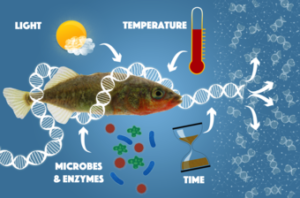Environmental DNA (eDNA) used to detect endangered bird species 19/11/2019 – Posted in: Daily News – Tags: Environment

eDNA
Environmental DNA (eDNA)
For: Preliminary & Mains
Topics covered:
- All about eDNA
News Flash
Environmental DNA (eDNA) is used to detect the presence/locations and numbers of an endangered bird species by collecting and analysing small amounts of water from the pools where they drink.
eDNA means DNA collected from environmental samples like soil, seawater, or even air rather than direct sampling from an individual organism. These sample collections can be used to detect the presence of threatened terrestrial species in an ecosystem.
Using eDNA, a team of researchers identified the movements of the stunning rainbow-coloured Gouldian finch (Erythrura gouldiae), a species native to tropical savanna woodlands in Australia’s north. The researchers developed a test in which multiple copies of a species-specific probe is made to detect Gouldian finch DNA.
Applications
- eDNA can be used to monitor species throughout the year and can be very useful in conservation monitoring.
- eDNA analysis has been successful at identifying many different taxa from aquatic plants, fishes, mussels, fungi and even parasites.
- eDNA has been used to study species while minimizing any stress inducing human interaction, allowing researchers to monitor species presence at larger spatial scales more efficiently. The most prevalent use in current research is using eDNA to study the locations of species at risk, invasive species, and keystone species across all environments.
- eDNA is especially useful for studying species with small populations because eDNA is sensitive enough to confirm the presence of a species with relatively little effort to collect data which can often be done with a soil sample or water sample.
- eDNA relies on the efficiency of genomic sequencing and analysis as well as the survey methods used which continue to become more efficient and cheaper. Some studies have shown that eDNA sampled from stream and inshore environment decayed to undetectable level at within about 48 hours.
- eDNA can be applied as a tool to detect low abundance organisms in both active and passive forms.
Source: India Today
READ MORE DAILY NEWS
- Sabarimala temple Issue: SC verdict
- Office of the CJI comes under the RTI Act
- 11th BRICS summit
- The Index of Industrial Production
- What is New Zealand’s Zero Carbon Law?
- Brown to Green Report 2019
- New National Water Policy
- Suranga Bawadi
- Bushehr – Nuclear Power Plant
You are on the Best Online IAS preparation platform. You are learning under experts.
We are present on Facebook- Diligent IAS, LinkedIn- Diligent IAS, YouTube- Diligent IAS, Instagram- Diligent IAS. Get in touch with us.
